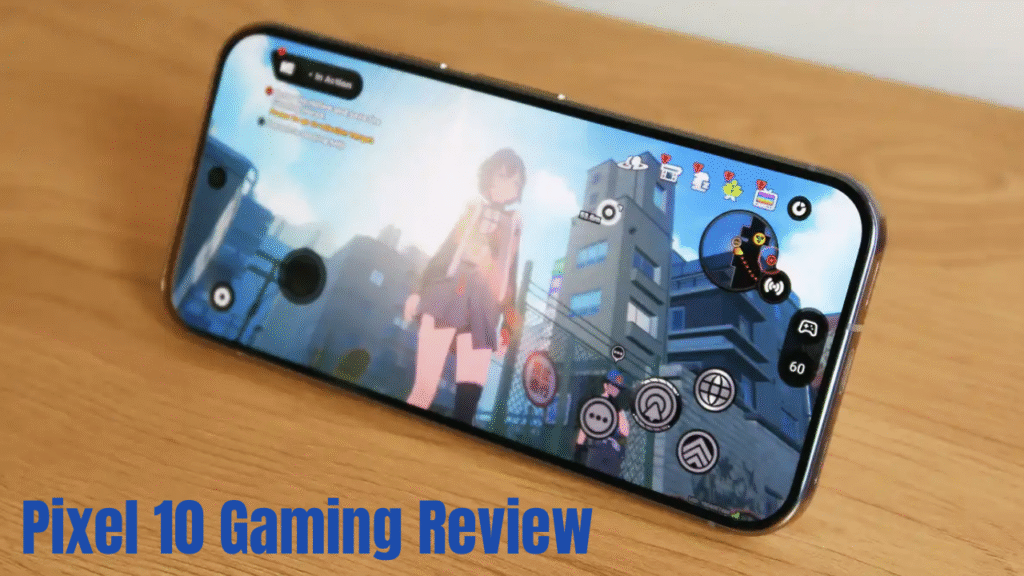Introduction

The Google Pixel 10 series is here with some major upgrades. This time, Google has added the Tensor G5 processor and switched to a completely new GPU architecture. Instead of ARM’s Mali GPU, Pixel 10 now runs on Imagination Technologies’ PowerVR DXT-48-1536 GPU.
The big question is: Can this new GPU finally make the Pixel good for gaming? Let’s break it down with real-world tests, benchmarks, and gaming experience.
Pixel 10 GPU – What Changed This Year?
Google’s decision to move from Mali GPU to PowerVR GPU is bold. Interestingly, this PowerVR series supports ray-tracing, but Google has disabled it on the Pixel 10.
- Benchmark boost: Performance is around 27% better than Pixel 9 in synthetic benchmarks.
- Heat issues: Pixel 10 runs slightly hotter, which affects long-term performance during extended gameplay.
- Flagship gap: Still not close to Snapdragon 8 Elite or Apple A18 Pro in raw gaming power.
So, while it’s an upgrade, it’s not a gaming powerhouse.
Gaming Test: Pixel 10 with Popular Titles
To check how well Pixel 10 handles real games, I installed and tested the most popular Android titles.
PUBG Mobile
- Booted without any problem.
- Smooth gameplay on default settings.
- With 60fps mode enabled, frame rates stayed stable above 30fps.
Call of Duty Mobile
- Installed quickly, no bugs or glitches.
- Gameplay felt smooth, responsive controls.
Genshin Impact
- Default graphics ran fine with no stutters.
- Easily handles medium to high settings.
Honkai Star Rail
- No crashes, loads fast.
- Stable frame rates during battles.
Diablo Immortal
- Installed and played perfectly.
- Visuals were good, no overheating in short sessions.
GRID Legends
- Game showed available in the Play Store (not on Pixel 9).
- But after installing, it said the phone doesn’t meet requirements.
- Shows Pixel 10 still has compatibility limitations compared to Snapdragon phones.
Emulation Test – Dolphin Emulator
To push the GPU further, I tried Mario Kart Wii on Dolphin Emulator.
- Both OpenGL and Vulkan backends worked.
- Some stutters appeared during asset loading.
- But overall, the game was playable without visual glitches like missing textures or lighting errors.
This means Pixel 10 is also fine for some casual emulation.
The Downsides of Pixel 10 Gaming
While Pixel 10 gaming performance is decent, it has a few drawbacks:
- Gets warm quickly during longer sessions.
- Not the most powerful chip compared to Snapdragon or Apple.
- Some games (like GRID Legends) show compatibility issues.
Who Should Buy Pixel 10 for Gaming?
- Hardcore gamers: If you want max FPS and best graphics, better pick OnePlus 13 or ASUS ROG Phone 9.
- Casual gamers: If you only play PUBG, COD, or Genshin sometimes, Pixel 10 is more than enough.
- Tech lovers: Beyond gaming, Pixel 10 shines with Google’s AI features and excellent cameras.
Conclusion
The Pixel 10’s new PowerVR GPU is a step forward. It’s not the best in the market, but it runs all the popular games smoothly, supports emulation, and doesn’t show major glitches.
Yes, it heats up and won’t match Snapdragon’s raw power, but if you are a casual gamer who values AI features, software, and camera quality, Pixel 10 is still worth it.
for more infor about this mobile visit store of google
Samsung Galaxy A17 5G Now Available in More European Countries
Oppo A6 Max Launches in China with a high Power 7,000 mAh Battery
Oppo Reno 14 FS 5G Launch-Powerful Display, Powerful Cameras Big Battery


[…] Pixel 10 Gaming Positive Review: The New GPU Handles Popular Games Smoothly […]